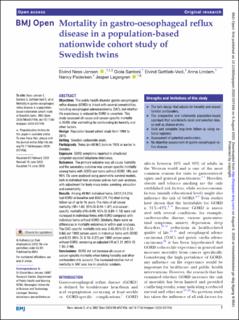| dc.contributor.author | Ness-Jensen, Eivind | |
| dc.contributor.author | Giola, Santoni | |
| dc.contributor.author | Gottlieb-Vedi, Eivind | |
| dc.contributor.author | Lindam, Anna | |
| dc.contributor.author | Pedersen, Nancy L | |
| dc.contributor.author | Lagergren, Jesper | |
| dc.date.accessioned | 2021-01-19T13:53:06Z | |
| dc.date.available | 2021-01-19T13:53:06Z | |
| dc.date.created | 2021-01-18T15:54:22Z | |
| dc.date.issued | 2020 | |
| dc.identifier.citation | BMJ Open. 2020, 10 (8), e037456-?. | en_US |
| dc.identifier.issn | 2044-6055 | |
| dc.identifier.uri | https://hdl.handle.net/11250/2723722 | |
| dc.description.abstract | Objectives The public health disorder gastro-oesophageal reflux disease (GORD) is linked with several comorbidities, including oesophageal adenocarcinoma (OAC), but whether life expectancy is reduced by GORD is uncertain. This study assessed all-cause and cancer-specific mortality in GORD after controlling for confounding by heredity and other factors.
Design Population-based cohort study from 1998 to 2015.
Setting Swedish nationwide study.
Participants Twins (n=40 961) born in 1958 or earlier in Sweden.
Exposure GORD symptoms reported in structured computer-assisted telephone interviews.
Outcomes The primary outcome was all-cause mortality and the secondary outcome was cancer-specific mortality among twins with GORD and twins without GORD. HRs and 95% CIs were analysed using parametric survival models, both in individual twin analyses and co-twin pair analyses, with adjustment for body mass index, smoking, education and comorbidity.
Results Among 40 961 individual twins, 5812 (14.2%) had GORD at baseline and 8062 (19.7%) died during follow-up of up to 16 years. The risks of all-cause mortality (HR=1.00, 95% CI: 0.94–1.07) and cancer-specific mortality (HR=0.99, 95% CI: 0.89–1.10) were not increased in individual twins with GORD compared with individual twins without GORD. Similarly, there were no differences in mortality outcomes in within-pair analyses. The OAC-specific mortality rate was 0.45 (95% CI: 0.32–0.66) per 1000 person-years in individual twins with GORD and 0.22 (95% CI: 0.18–0.27) per 1000 person-years without GORD, rendering an adjusted HR of 2.01 (95% CI: 1.35–2.98).
Conclusions GORD did not increase all-cause or cancer-specific mortality when taking heredity and other confounders into account. The increased relative risk of mortality in OAC was low in absolute numbers. | en_US |
| dc.language.iso | eng | en_US |
| dc.publisher | BMJ Publishing Group | en_US |
| dc.rights | Navngivelse 4.0 Internasjonal | * |
| dc.rights.uri | http://creativecommons.org/licenses/by/4.0/deed.no | * |
| dc.title | Mortality in gastro-oesophageal reflux disease in a population-based nationwide cohort study of Swedish twins | en_US |
| dc.type | Peer reviewed | en_US |
| dc.type | Journal article | en_US |
| dc.description.version | publishedVersion | en_US |
| dc.source.pagenumber | e037456-? | en_US |
| dc.source.volume | 10 | en_US |
| dc.source.journal | BMJ Open | en_US |
| dc.source.issue | 8 | en_US |
| dc.identifier.doi | 10.1136/bmjopen-2020-037456 | |
| dc.identifier.cristin | 1873482 | |
| dc.description.localcode | © Author(s) (or their employer(s)) 2020. Re-use permitted under CC BY. Published by BMJ. | en_US |
| cristin.ispublished | true | |
| cristin.fulltext | original | |
| cristin.qualitycode | 1 | |

